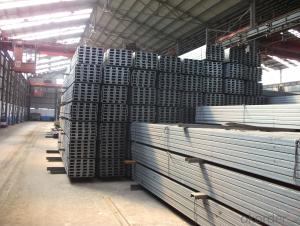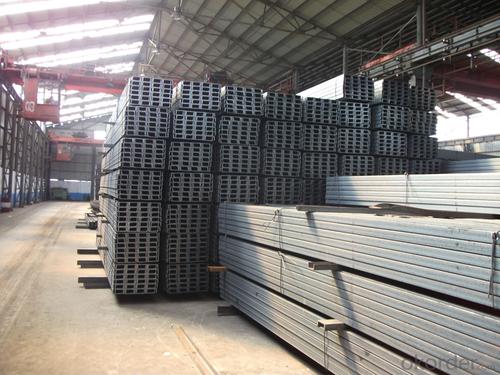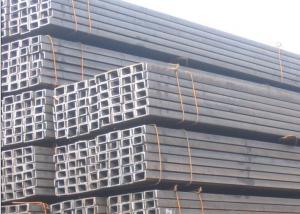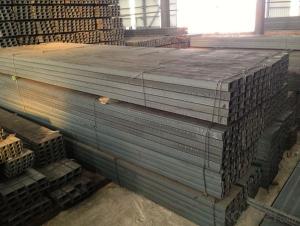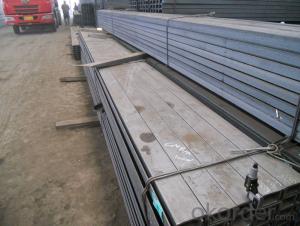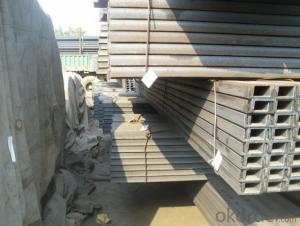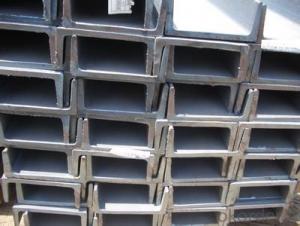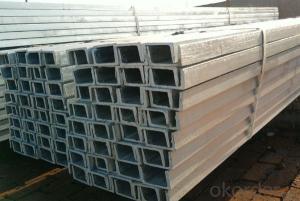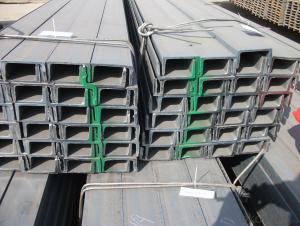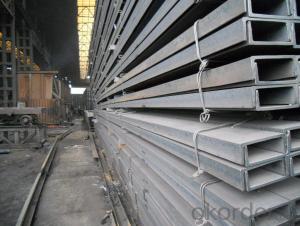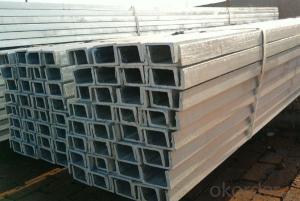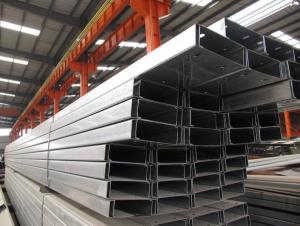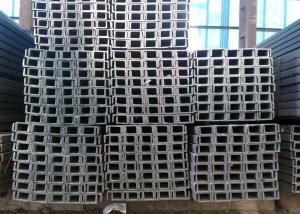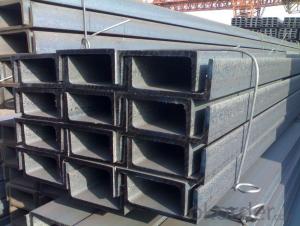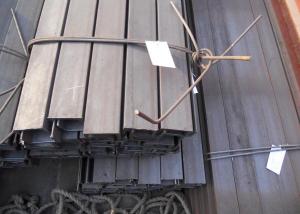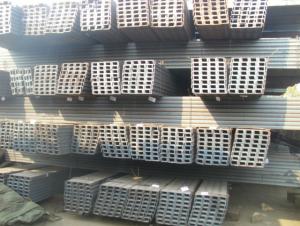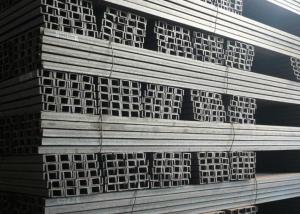HOT ROLLED U CHANNEL 75*40 6M JIS STANDER
- Loading Port:
- Qingdao
- Payment Terms:
- TT OR LC
- Min Order Qty:
- 50 m.t.
- Supply Capability:
- 10000 m.t./month
OKorder Service Pledge
OKorder Financial Service
You Might Also Like
Product Description:
Specifications of MS Channel:
1.We supply high quality MS Channel at reasonable price, including Chinese standard, Japanese standard and so on.
Standard | GB/JIS |
Material Grade | Q235,SS400 |
Technique: | Hot Rolled |
Sizes as per chinese standard: | 50*37*4.5mm - 300*89*11.5mm |
Sizes as per japanese standard: | 50*25*3mm – 200*80*7.5mm |
Length: | 6meter, 9meter, 12meter |
Note: 1.we are also competent to provide our customers other MS Channel based on other sizes according to customer’s requirements.
2. The length of our ms channel could be cut into other meters as per customer’s requirements. For example, the channel in 6meters could be cut into 5.8meters in order to be fit in the 20ft container.
2. The detailed sections of MS Channel as per GB standard.are shown in the table-1:
GB U CHANNEL | Standard | Sectional | Dimension |
| Mass: |
| (mm) | (mm) | (mm) | (mm) |
|
50X37 | 50 | 37 | 4.50 | 7.0 | 5.438 |
63X40 | 63 | 40 | 4.80 | 7.5 | 6.634 |
80x43 | 80 | 43 | 5.00 | 8.0 | 8.045 |
|
|
|
|
|
|
100x48 | 100 | 48 | 5.30 | 8.5 | 10.007 |
120x53 | 120 | 53 | 5.50 | 9.0 | 12.059 |
140x58 | 140 | 58 | 6.00 | 9.5 | 14.535 |
140x60 | 140 | 60 | 8.00 | 9.5 | 16.733 |
|
|
|
|
|
|
160x63 | 160 | 63 | 6.50 | 10.0 | 17.240 |
160x65 | 160 | 65 | 8.50 | 10.0 | 19.752 |
|
|
|
|
|
|
180x68 | 180 | 68 | 7.00 | 10.5 | 20.174 |
180x70 | 180 | 70 | 9.00 | 10.5 | 23.000 |
|
|
|
|
|
|
200x73 | 200 | 73 | 7.00 | 11.0 | 22.637 |
200x75 | 200 | 75 | 9.00 | 11.0 | 25.777 |
|
|
|
|
|
|
220x77 | 220 | 77 | 7.00 | 11.5 | 24.999 |
220x79 | 220 | 79 | 9.00 | 11.5 | 28.453 |
|
|
|
|
|
|
250x78 | 250 | 78 | 7.00 | 12.0 | 27.410 |
250x80 | 250 | 80 | 9.00 | 12.0 | 31.335 |
250x82 | 250 | 82 | 11.00 | 12.0 | 35.260 |
|
|
|
|
| |
280x82 | 280 | 82 | 7.50 | 12.5 | 31.427 |
280x84 | 280 | 84 | 9.50 | 12.5 | 35.823 |
280x86 | 280 | 86 | 11.50 | 12.5 | 40.219 |
|
|
|
|
|
|
300x85 | 300 | 85 | 7.50 | 13.5 | 34.463 |
300x87 | 300 | 87 | 9.50 | 13.5 | 39.173 |
300x89 | 300 | 89 | 11.50 | 13.5 | 43.883 |
Table-1
3. The chemical composition of HR Channel Steel according to Q235B is shown in Table-2.
Alloy No | Grade | Element(%) | ||||
C | Mn | S | P | Si | ||
Q235 | B | 0.12-0.20 | 0.3-0.7 | ≦0.045 | ≦0.045 | ≦0.3 |
Table-2
Note: we are able to present our customers relevant SGS test report for chemical composition of HR Channel Steel.
4. The mechanical property of HR Channel Steel according to Q235B is shown in Table-3-1 and Table-3-2
Alloy No | Grade | Yielding Strength Point(Mpa) | |||
Thickness(mm) | |||||
≦16 | >16-40 | >40-60 | >60-100 | ||
≧ | |||||
Q235 | B | 235 | 225 | 215 | 205 |
Table-3-1
Alloy No | Grade | Tensile Strength(Mpa) | Elongation After Fracture(%) | |||
Thickness(mm) | ||||||
≦16 | >16-40 | >40-60 | >60-100 | |||
≧ | ||||||
G235 | B | 375-500 | 26 | 25 | 24 | 23 |
Table-3-2
Note: we are able to present our customers relevant SGS test report for mechanical property of MS Channel as customer’s request.
Applications of MS Channel:
The MS Channel can be applied to construction of warehouses, workshops, sport stadiums and car parks etc.The hot rolled channel steel belongs to carbon structural steel which is applied to in the field of construction and machinery.In details, the hot rolled channel steel is usually used for arch-itechtural structure, and they could be welded in order to support or hang a vari-ety of facilities. They are also usually used in combination with I beam. Generally,the hot rolled channel steel we supply must possess perfect welding property, riveting property and mechanical property and so on.
Package & Delivery of MS Channel:
1.The hot rolled channel steel will be packed in bundle with steel wire at each end of every bundle and color marking in order to help the customer to recognize his goods more easily at sight.
2. And the hot rolled channel steel could be loaded into 20ft or 40ft container, or by bulk cargo.If the weight of each bundle reaches more than 3.5 mt, the loading by break bulk cargo should be choosed.When the weight of each bundle reaches less than 3mt, the loading by container should be choosed.
3.As for the transportaion from mill to loading port, the truck will be usually used. And the maximum quantity for each truck is 40mt.
4.All in all, we could do in accordance with customer's request.
- Q: Are steel channels suitable for use in agricultural applications?
- Yes, steel channels are indeed suitable for use in agricultural applications. They possess numerous characteristics that render them ideal for agricultural use. First and foremost, steel channels are characterized by their strength and durability, which enables them to provide exceptional structural support. This is of utmost importance in agricultural applications where heavy loads or equipment may be involved. Moreover, steel channels exhibit a high resistance to environmental factors such as corrosion, rust, and weathering. This is particularly crucial in agricultural settings where exposure to various weather conditions and chemicals is commonplace. The durability of steel channels ensures long-lasting performance, thereby minimizing the need for frequent replacements or repairs. In addition, steel channels are highly versatile and can be easily customized to meet specific agricultural requirements. They can be cut, welded, and shaped to accommodate different dimensions and configurations. This adaptability allows for effortless installation and integration into a variety of agricultural structures, including barns, sheds, fences, and equipment. Furthermore, steel channels provide fire resistance, which is of paramount importance in agricultural applications where fire hazards are present, such as in storage facilities or in proximity to machinery. The inherent fire-resistant properties of steel serve to safeguard the agricultural infrastructure and mitigate the risk of damage or loss. Lastly, steel channels prove to be cost-effective in the long run. While the initial investment may be higher compared to alternative materials, the durability and low maintenance requirements of steel channels lead to reduced costs associated with repairs and replacements over time. All in all, steel channels are an exceptional choice for agricultural applications due to their strength, durability, resistance to environmental factors, versatility, fire resistance, and cost-effectiveness. These attributes render them suitable for a broad range of agricultural structures and equipment, ensuring reliable and long-lasting performance in the agricultural industry.
- Q: How do steel channels perform under vibration?
- Steel channels exhibit excellent performance when subjected to vibrations due to their high strength and stiffness. The durability and structural integrity of steel channels enable them to withstand dynamic loads and vibrations without experiencing significant deformation or failure. The exceptional properties of steel, including its high modulus of elasticity and superior damping characteristics, aid in absorbing and dissipating the energy generated by vibrations. In applications where resistance to vibrations is crucial, steel channels are commonly utilized, particularly in the construction and transportation industries. They play a vital role in the design of bridges, buildings, and industrial equipment, providing reliable support and stability when subjected to dynamic loads and vibrations. To further enhance their performance in vibrating environments, steel channels can be designed with additional features such as reinforcement ribs or sandwich structures. These design modifications increase their stiffness and damping properties, thereby minimizing vibration amplitudes and reducing the risk of fatigue or failure. Nevertheless, it is important to acknowledge that the performance of steel channels under vibrations can vary depending on several factors, including design, material properties, and the magnitude and frequency of the vibrations. Consequently, proper engineering analysis and design considerations, such as selecting the appropriate steel grade and cross-sectional shape, are crucial to ensure optimal performance and safety in environments prone to vibrations.
- Q: Can steel channels be used for signage installations?
- Signage installations can indeed utilize steel channels. These channels offer a strong and enduring framework that supports and mounts signage. They are widely employed in outdoor signage installations, including billboards, roadside signs, and large-scale displays. Due to their exceptional structural integrity, steel channels can withstand diverse weather conditions, guaranteeing the stability and long life of the signage. Moreover, steel channels can be tailored and crafted to meet the precise requirements of the signage, enabling accurate installation and alignment. All in all, steel channels are a dependable and resilient option for signage installations.
- Q: What are the different methods of joining steel channels together?
- There are several methods for joining steel channels together, each with its own advantages and limitations. Some common methods include welding, bolting, riveting, and adhesive bonding. Welding is a widely used method that involves melting the edges of the steel channels and fusing them together. It provides a strong and durable joint, but it requires skilled welders and specialized equipment. Welding can be done using various techniques such as arc welding, MIG welding, TIG welding, or spot welding, depending on the specific application and requirements. Bolting involves using bolts and nuts to connect steel channels. This method is relatively simple and allows for easy disassembly and adjustments, making it suitable for applications that require flexibility. However, it may not provide the same level of strength as welding, and the use of additional reinforcement might be necessary in high-stress situations. Riveting is another method that involves using metal fasteners called rivets to join steel channels. It has been widely used in the past but is less common nowadays due to the availability of more efficient joining techniques. Riveting can provide a strong joint, but it requires special tools and skills to install the rivets properly. Adhesive bonding involves using specialized adhesives to join steel channels together. This method offers several advantages, such as being non-invasive, providing a smooth and aesthetically pleasing finish, and allowing for even distribution of stress across the joint. Adhesive bonding can be a suitable option for joining steel channels when other methods are not practical or desirable. Ultimately, the choice of joining method for steel channels depends on factors such as the application requirements, the desired strength and durability, the available resources, and the expertise of the personnel involved. It is important to carefully evaluate these factors and consult with professionals to determine the most appropriate method for a specific project.
- Q: Can steel channels be used in food processing facilities?
- Indeed, steel channels find application in food processing facilities. Their durability, strength, and resistance to corrosion make them a popular choice in the construction of industrial facilities. Particularly in food processing facilities, where maintaining hygiene and cleanliness is of utmost importance, stainless steel channels are often the preferred option. Stainless steel, being resistant to rust, can endure exposure to water, chemicals, and high temperatures without corroding or contaminating food products. These channels serve various purposes in food processing facilities, such as supporting equipment, creating partitions, and forming structural elements. Furthermore, stainless steel channels are easily cleanable and maintainable, making them well-suited for environments that demand strict cleanliness and sanitation standards.
- Q: Can steel channels be used in the construction of elevated walkways?
- Yes, steel channels can be used in the construction of elevated walkways. Steel channels, also known as C-channels, are commonly used in construction due to their strength and durability. They are suitable for supporting heavy loads and can be designed to provide the necessary structural integrity for elevated walkways. Steel channels offer excellent resistance to bending and twisting forces, making them ideal for creating stable and secure walkways at heights. Additionally, steel channels can be easily fabricated and installed, allowing for efficient construction of elevated walkways. Overall, steel channels are a reliable and popular choice for the construction of elevated walkways.
- Q: What are the common safety considerations in the design of steel channels?
- When designing steel channels, there are several common safety considerations that need to be taken into account to ensure the overall safety and structural integrity of the channels. These considerations include: 1. Load-bearing capacity: One of the primary safety concerns is ensuring that the steel channels have sufficient load-bearing capacity to support the intended loads. This involves analyzing the expected loads, such as the weight of the materials or equipment that will be placed on the channels, and designing the channels with adequate strength and stiffness to withstand these loads without failure. 2. Material selection: The choice of material for the steel channels is another important safety consideration. The material should have the necessary strength and durability to withstand the anticipated loads, as well as resistance to corrosion, fire, and other potential hazards. The material should also meet the relevant industry standards and specifications. 3. Structural stability: The design of steel channels should ensure their structural stability, which involves considerations such as the proper sizing and positioning of the channels, the use of appropriate connections, and the incorporation of bracing or other reinforcement elements if needed. Structural stability is crucial to prevent buckling, collapse, or other forms of failure under load. 4. Fire resistance: In certain applications, fire resistance is a critical safety consideration for steel channels. Depending on the location and purpose of the channels, they may need to be designed to withstand high temperatures and prevent the spread of fire. This can involve using fire-resistant coatings or insulation materials and designing for proper ventilation to prevent the buildup of heat. 5. Accessibility and ergonomics: Safety considerations also extend to the accessibility and ergonomics of the steel channels, especially in industrial or construction settings. Designers should ensure that the channels are easily accessible for installation, inspection, and maintenance tasks, and that they are designed to minimize potential hazards or risks to workers who may interact with them. 6. Compliance with codes and regulations: Finally, it is essential to consider the relevant codes, standards, and regulations when designing steel channels. Compliance with these requirements ensures that the channels meet the necessary safety standards and are fit for their intended purpose. By addressing these common safety considerations in the design of steel channels, engineers and designers can create structures that are safe, reliable, and able to withstand the intended loads and environmental conditions.
- Q: Can steel channels be used in underground construction?
- Indeed, underground construction can make use of steel channels. These versatile structural elements offer robustness and reinforcement to subterranean structures. Their exceptional strength-to-weight ratio renders them ideal for enduring substantial loads and pressures in underground settings. Furthermore, steel channels can be effortlessly manufactured and tailored to fulfill precise design specifications. They find frequent application in underground construction, serving as support beams, tunnel linings, and underground storage facilities. Moreover, the corrosion-resistant attributes of steel guarantee the durability and security of these underground projects, thereby ensuring their long-lasting functionality.
- Q: Are steel channels suitable for high-traffic areas?
- Yes, steel channels are suitable for high-traffic areas. Steel is a durable and strong material that can withstand heavy foot traffic and is resistant to wear and tear. Additionally, steel channels provide structural support and stability, making them ideal for areas with frequent and heavy use.
- Q: How are steel channels protected against rusting and corrosion?
- Steel channels are protected against rusting and corrosion through various methods such as coating them with corrosion-resistant materials like zinc or paint, galvanizing them by applying a layer of zinc through a hot-dip process, or using stainless steel channels which have inherent resistance to rusting and corrosion.
Send your message to us
HOT ROLLED U CHANNEL 75*40 6M JIS STANDER
- Loading Port:
- Qingdao
- Payment Terms:
- TT OR LC
- Min Order Qty:
- 50 m.t.
- Supply Capability:
- 10000 m.t./month
OKorder Service Pledge
OKorder Financial Service
Similar products
Hot products
Hot Searches
Related keywords
